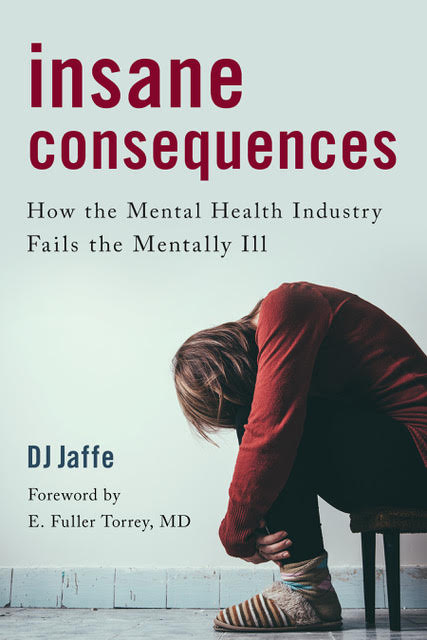In spite of spending over $1.5 billion a year in Mental Health Services Act (MHSA) funds, mentally ill homeless camps are taking over downtowns, four times as many Californians with mental illness are incarcerated as hospitalized, and even educated and caring moms can’t get care for seriously mentally ill loved ones. Why is that? Wasn’t MHSA supposed to solve these problems? It was and it hasn’t. And because the funds come from a 1% tax on millionaires, many of whom are business owners, it is in their interest to help fix the problem.
While conducting research for my book “Insane Consequences: How the Mental Health Industry Fails the Mentally Ill,” I discovered that while MHSA was supposed to help the seriously ill—often those with schizophrenia or severe bipolar disorder—mental health industry insiders were put in charge of distributing the funds and they too often divert them to feel-good programs that pad their bottom lines, but don’t help the seriously mentally ill.
The almost total lack of accountability in how these funds are being spent was described by the State Auditor, two Little Hoover Commission Reports, a Mental Illness Policy Org report, and an AP story that revealed yoga, line dancing, family activity nights, creative learning circles, and homework clubs, all qualified for MHSA funding even though have nothing to do with preventing homelessness, arrest, incarceration or hospitalization of the seriously mentally ill.
Some MHSA funds clearly do help the most seriously mentally ill. But even the highly-touted Full Service Partnership (FSP) program which promises to do “whatever it takes” refuses to serve those are so sick they don’t know they are sick. There is no data on the diagnosis of those being served or on meaningful metrics like rates of homelessness, arrest, and incarceration so even with FSP programs, we can’t tell how well they are working.
Much of the 20% ($320 million) of MHSA funds that is allocated to Prevention and Early Intervention (PEI) programs has been diverted to pop-psychology. Schizophrenia and bipolar disorder most often begins in late teens and early twenties yet funds are diverted to youth; schizophrenia and bipolar disorder cannot be prevented, yet dollars are diverted to prevention; suicide campaigns have not been effective at reducing suicide, yet suicide campaigns are rampant. And rather than being targeted at those most likely to commit suicide, those over 50, they are targeted at school kids, the least likely to commit suicide. Suicide and incarceration of the mentally ill is rising while people like Darrell Steinberg propose more ways to appease the mental health industry by raiding the MHSA fund for programs like housing or services for criminal offenders without guaranteeing the funds will be used only to house those with serious mental illness or serve offenders with serious mental illness.
There are three levels of oversight where business and criminal justice leaders should intervene.
Counties have behavioral health planning boards that recommend where county PEI funds are spent; the state has a Mental Health Services Oversight and Accountability Commission (MHSOAC); and there are leaders in Sacramento. All have failed to ensure funds reach the seriously mentally ill or prevent schemes emanating from MHA and the Steinberg Institute to divert them.
The local planning boards wrap bad grades, divorce, poverty, unemployment, lack of comfort with sexual identity in a mental health narrative so county MHSA funds can be channeled to them. Rather than promoting the use of MHSA funds for Laura’s Law, California’s most successful program to reduce incarceration and homelessness among the seriously mentally ill, they thwart it at every turn. County mental health directors look at the members of the planning boards, not the seriously mentally ill or the public as their constituency, and so they rubber-stamp these proposals rather than saying ‘no.’ Business and especially criminal justice leaders should join the planning boards, insist behavioral health directors reject plans that don’t serve the seriously ill, or urge their county boards of supervisors to fire directors who won’t insist the funds are used to address the needs of the seriously ill.
The state oversight and accountability commission also offers opportunity for reform. Only two of the Governor’s twelve appointees to the commission are required to be mental health professionals, but almost all are. They send funds to their own programs and others that purport to improve mental wellness rather than treat the seriously ill. Mental health care experts, rather than business executives, fill the slots of “a representative of an employer with less than 500 employees’ and ‘a representative of an employer with more than 500 employees.” Business leaders and sheriffs should insist those slots be filled with Chamber of Commerce or other business leaders who are dedicated to improving downtowns rather than maintaining the funding stream for programs that fail to help.
 As long as the California business community allows MHSA funds to go to programs that don’t help the seriously mentally ill, allow legislative raids on the funds for programs that are not guaranteed to serve the seriously ill, and refuse to demand implementation of Laura’s Law and expansion of inpatient facilities, there is little likelihood the lot of California’s seriously mentally ill will be improved. More money is not the answer. Involvement of the business community is.
As long as the California business community allows MHSA funds to go to programs that don’t help the seriously mentally ill, allow legislative raids on the funds for programs that are not guaranteed to serve the seriously ill, and refuse to demand implementation of Laura’s Law and expansion of inpatient facilities, there is little likelihood the lot of California’s seriously mentally ill will be improved. More money is not the answer. Involvement of the business community is.
DJ Jaffe is author of Insane Consequences: How the Mental Health Industry Fails the Mentally Ill and executive director of Mental Illness Policy Org. He will be speaking at free book events throughout California the week of May 20-26.

